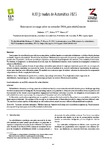Mostrar o rexistro simple do ítem
Estimación de carga sobre un actuador SMA para rehabilitación
| dc.contributor.author | Ballester Bernabeu, Carmen | |
| dc.contributor.author | Muñoz Sánchez, Víctor | |
| dc.contributor.author | Blanco, Dolores | |
| dc.date.accessioned | 2023-10-11T17:14:43Z | |
| dc.date.available | 2023-10-11T17:14:43Z | |
| dc.date.issued | 2023 | |
| dc.identifier.citation | Ballester, C., Muñoz, V., Blanco, D. 2023. Estimación de carga sobre un actuador SMA para rehabilitación. XLIV Jornadas de Automática, 507-511. https://doi.org/10.17979/spudc.9788497498609.507 | es_ES |
| dc.identifier.isbn | 978-84-9749-860-9 | |
| dc.identifier.uri | http://hdl.handle.net/2183/33748 | |
| dc.description.abstract | [Resumen] Las terapias de rehabilitación que utilizan exoesqueletos vestibles basados en materiales inteligentes y robótica blanda plantean un desafío respecto a la medición directa de las bioseñales. Mediante la incorporación de sensores, es posible obtener información precisa sobre la posición y la fuerza ejercida por el paciente, mejorando la participación del paciente y los resultados de la terapia. No obstante, la integración de dichos sensores en los trajes de rehabilitación blandos puede aumentar la complejidad del sistema y reducir su flexibilidad. En este estudio se aplican técnicas de aprendizaje automático para estimar la carga que el paciente ejerce sobre un exoesqueleto actuado mediante materiales con memoria de forma. Se utiliza el análisis de la curva de enfriamiento característica de estas aleaciones para clasificar entre diferentes cargas. El resultado es un sistema capaz de estimar información clave sobre la recuperación del paciente sin añadir complejidad adicional. | es_ES |
| dc.description.abstract | [Abstract] Rehabilitation therapies involving wearable exoskeletons based on smart materials and soft robotics pose a challenge regarding the direct measurement of biosignals. By incorporating sensors, it is possible to obtain accurate information about the position and force exerted by the patient, improving patient engagement and therapy outcomes. However, the integration of such sensors into soft rehabilitation suits may increase the complexity of the system and reduce its flexibility. In this study, machine learning techniques are applied to estimate the load exerted by the patient on an exoskeleton actuated by shape memory materials. The analysis of the cooling curve characteristic of these alloys is used to classify between different loads. The result is a system capable of estimating key information about patient recovery without adding additional complexity. | es_ES |
| dc.language.iso | spa | es_ES |
| dc.publisher | Universidade da Coruña. Servizo de Publicacións | es_ES |
| dc.relation.uri | https://doi.org/10.17979/spudc.9788497498609.507 | es_ES |
| dc.rights | Attribution-NonCommercial-ShareAlike 4.0 lnternational (CC BY-NC-SA 4.0) https://creativecommons.org/licenses/by-ncsa/4.0/ | es_ES |
| dc.rights.uri | http://creativecommons.org/licenses/by-nc-sa/3.0/es/ | * |
| dc.subject | Estimación de parámetros y estados | es_ES |
| dc.subject | Aprendizaje automático | es_ES |
| dc.subject | Tecnología asistencial e ingeniería de rehabilitación | es_ES |
| dc.subject | Aprendizaje por refuerzo y aprendizaje profundo en control | es_ES |
| dc.subject | Mecatrónica biomédica | es_ES |
| dc.subject | Parameter and state estimation | es_ES |
| dc.subject | Machine learning | es_ES |
| dc.subject | Assistive technology and rehabilitation engineering | es_ES |
| dc.subject | Reinforcement learning and deep learning in control | es_ES |
| dc.subject | Biomedical mechatronics | es_ES |
| dc.title | Estimación de carga sobre un actuador SMA para rehabilitación | es_ES |
| dc.title.alternative | Load estimation on an SMA actuator for rehabilitation | es_ES |
| dc.type | info:eu-repo/semantics/conferenceObject | es_ES |
| dc.rights.access | info:eu-repo/semantics/openAccess | es_ES |
| UDC.startPage | 507 | es_ES |
| UDC.endPage | 511 | es_ES |
| dc.identifier.doi | https://doi.org/10.17979/spudc.9788497498609.507 | |
| UDC.conferenceTitle | XLIV Jornadas de Automática | es_ES |






